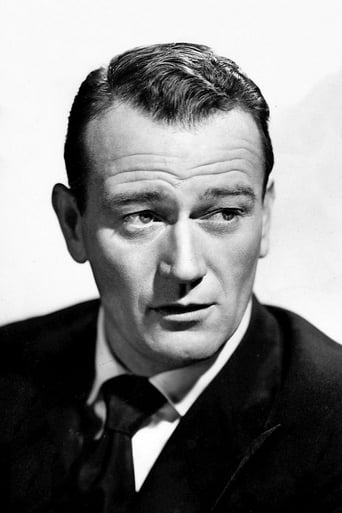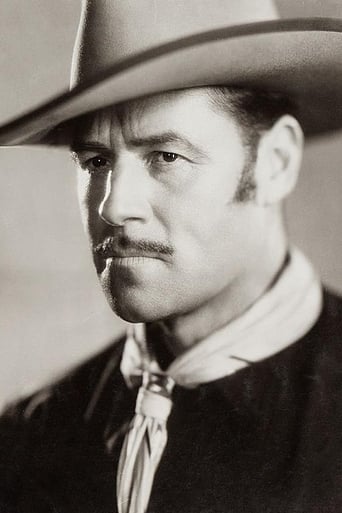Jeanskynebu
the audience applauded
Huievest
Instead, you get a movie that's enjoyable enough, but leaves you feeling like it could have been much, much more.
Lachlan Coulson
This is a gorgeous movie made by a gorgeous spirit.
Ella-May O'Brien
Each character in this movie — down to the smallest one — is an individual rather than a type, prone to spontaneous changes of mood and sometimes amusing outbursts of pettiness or ill humor.
dfwesley
I've seen this twice and enjoyed it immensely both times. The lack of action does not hinder the quality of this war movie in any way. Rather THEY WERE EXPENDABLE depicts a gamut of emotions that make battle scenes unnecessary. Robert Montgomery, John Wayne, and Donna Reed are masterful in their portrayals of naval officers and nurse. One of my favorite sentimental scenes is the dinner for nurse, Sandy. Reed and Wayne's facial expressions were standouts. Of course, the last scene as the plane flies into the sunset leaving a host of hopeless personnel on the field, is very touching as is the dying officer in Corregidor's tunnel.An able cast of supporting actors, headed by Ward Bond, contribute much to the film. It is the largest role I ever saw for Jack Pennick who was "Doc". Pennick, an actual veteran of several wars plus, certainly was at home in uniform.We all remember that President Kennedy served and was injured while serving on a PT boat and that story is on film. PT boats gave up their torpedoes late in the war as mostly very small targets remained and they assumed rather a a gunboat function.Not your typical war movie but a great one, and it ranks up there with the best.
Bill Slocum
Released at the end of World War II, with the ink on the final surrender documents still fresh, "They Were Expendable" is a rousing yet sobering look back when American service personnel faced total defeat at enemy hands. It's not a question of "if" for them, just "when," and this is director John Ford's way of paying tribute.We open in December, 1941, as Lt. John Brickley (Robert Montgomery) is trying to make his superiors see the value of the squadron of PT- boats he commands, presently stationed on Cavite in the Philippines. The brass is not impressed, but then the Japanese begin their offensive and Brickley and his men are put to the test. Can these "high-powered canoes" be counted on to help turn the tide of Japanese cruisers and destroyers?Not really, not for long.Surprisingly for a film made while the war in the Pacific still raged, there is an overall tone of resignation bordering on despair, beginning with the title. A lot of things turn out expendable in this movie, not just the PT-boats and the rest of the American forces in the Philippines, but comradeships formed within the squadron, too. Brickley's second-in-command Rusty Ryan (John Wayne) even has to shed a promising romance with nurse Sandy Davyss (Donna Reed) as the exigencies of war take precedence.The message of "do-and-die" is presented early by Brickley's commander: "You and I are professionals. If the manager says sacrifice, we lay down a bunt and let somebody else hit the home runs."Wayne is the reason people watch "Expendable," but Montgomery is why it sticks. A combat veteran just back from the war, he keeps it real with a low-key performance. There's no shouting when he issues commands, just firm authority. No longer the pretty boy of 1930s cinema, Montgomery is haggard-looking here, with bags under his eyes, a five-'o-clock shadow, and a noticeable paunch. He's not trying to impress anyone, which is why he is so impressive."Who are you working for?" is something he asks Rusty at key moments in the beginning and at the end of the film. This is the moral of the picture, reminding us of the sacrifice being laid.For Ford and screenwriter Frank "Spig" Wead, that sacrifice takes precedence over story. "They Were Expendable" is an episodic, sometimes rambling affair, with more than a bit of hyperbole about what the PT-boats accomplished. Much time is taken up with the squadron's part in the evacuation of Gen. Douglas MacArthur, whom Ford treats as such a holy thing he is never referred to by name. He's simply called "certain key personnel" and draws admiring stares from all. It's understandable given MacArthur's credited role in turning the war, but it does grate.The pathos is deep, but never overwhelming. A deathbed scene between Brickley and one of his officers, whom we earlier see being introduced to the rest the squadron on the eve of the Pearl Harbor attack, is a masterful study of actorly control by both Montgomery and Paul Langton. Several key players in the Ford acting troupe have standout scenes, and with Ford manage to incorporate needed doses of humor in small but strategic ways.I really like Wayne in this movie; already a star, we see him here beginning to emerge as an actor, whether grousing about PT-duty early on, making a hash of an attempt at telling Sandy he loves her on a bad telephone connection, or reciting verse over two dead comrades. While Montgomery sets the tone of the film, Wayne provides the crucial backbone for it to work.In a way, the great strength of "They Were Expendable" is also a weakness; that it was made when the subject was not only fresh but still an open wound. It was hard for Ford and his cast to be as objective and detached from the matter as great art often is, to find a way of dealing with the hard truth that the fight for the Philippines was not just a defeat but a useless one where PT-boats proved of minimal help. All the talk of duty gets frustrating when one thinks of the overwhelming futility behind it."They Were Expendable" best works as a requiem, speaking of loss and man's hope for nobility in the face of same. It reminds us of whatever bad turns fate has in store for us, we need to be strong and face them out with determination, not necessarily because it will do any good but because it is the best we can do.
ilprofessore-1
This the first feature film John Ford made immediately after the Second World War, and, in the main titles, he is credited by his military rank. Although, the film is a deeply patriotic tribute to the little boats and the big men who were truly expendable in the larger picture, the film is notable for its unmistakable understatement. It is as if Ford, always given to cinema melodramatics in the name of a good show, somehow restrained himself, perhaps because the memory of what really happened, rather than what the establishment wanted its citizens to believe, was still very fresh in his mind. For once, he chose to tell the truth and not exaggerate. The performances from the starring roles to the bits are also particularly subdued and real. No false heroics. The handsome leading man and light comedian Robert Montgomery, who in real life was a PT boat commander, was never better. The mood of the film is enormously helped by the realistic semi-documentary cinematography of Joe August, whom Ford knew and collaborated with the early days of the silent cowboy film. August's lighting, often leaving characters in shadow or half-light, was very courageous for the time. Few big studio DPs, with the exception of Greg Toland, had the guts or the talent to avoid the clichés of big studio glamor lighting and try for something that looks at times very much like the documentaries Ford had made with his war-time naval unit. Today, Ford, one of the masters of the language of film, is often put down for his jingoism, but, as this film demonstrates, he was at his best a master story-teller and humanist.
bprp-1
One has to remember the time that this film was released-1945--so there is quite a bit of flag waving here . Especially with the attacks on the Japanese "cruisers " and sinking of a light Japanese aircraft carrier .No Japanese naval ships were indeed lost during this period , only 3 destroyers sunk by US submarines .As well when the PT boats were on their torpedo runs I am quite sure the Japanese ships were out of range of the machine guns firing from the PT boats.Indeed a summary of Japanese naval actions in this period list the cruiser Kuma (One torpedo struck bow but did not explode) South of Cebu 9 Apr 1942 by PT boats .The acting is understated which does work well.AS well the attacks of the Japanese aircraft is quite realistic no CGI here .The fall of the Philippines is indeed a fascinating subject .The mistakes,bravery, and suffering of the allied forces deserves a modern treatment -now that most of the facts are known .Hoping that film will be made.








